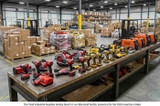The Importance and Classification of Hand Tools: A Detailed Guide
The Importance and Classification of Hand Tools: A Detailed Guide
Discover the essential role of hand tools in various industries and learn about their classifications in our comprehensive guide. From understanding their specific uses to choosing the right tool for your needs, this article provides valuable insights for professionals and DIY enthusiasts. Visit Tend Industrial Supplies for quality hand tools.
Introduction
Hand tools have been the cornerstone of craftsmanship and industry for thousands of years. From the earliest civilizations to the modern era, these tools have played a pivotal role in shaping our world. Whether it's a simple hammer for a construction project or a precision screwdriver for intricate electronics work, hand tools are essential to our daily lives. Understanding the classification of these tools is equally important as it helps us to use them more effectively and safely.
The Importance of Hand Tools
Hand tools are indispensable in various fields, including construction, woodworking, electronics, and automotive repair. They offer a level of control and precision often unmatched by power tools. Hand tools are also more portable and less expensive than their powered counterparts, making them accessible to professionals and DIY enthusiasts alike.
A. The Essential Role of Hand Tools in Different Fields
In construction and woodworking, hand tools such as hammers, saws, and chisels are used for various tasks, from framing a house to crafting intricate furniture. These tools allow craftsmen to shape and manipulate materials in ways that would be difficult, if not impossible, with power tools.
In electronics, precision hand tools like screwdrivers, pliers, and wire strippers are crucial. They allow technicians to assemble, repair, and modify delicate electronic components without causing damage.
Automotive repairis another field where hand tools are vital. Wrenches, ratchets, and sockets are just a few of the tools mechanics use to maintain and repair vehicles. These tools allow mechanics to reach into tight spaces and apply the precise amount of force needed to remove or install parts.
B. How Hand Tools Contribute to Efficiency and Productivity
Hand tools contribute significantly to efficiency and productivity in various ways. For one, they allow for a high degree of control, which can lead to better quality work. For example, a craftsman using a hand plane can achieve a level of smoothness and precision that is hard to match with power tools.
Hand tools also tend to be more reliable and less prone to failure than power tools. They don't require electricity or batteries to operate, which means they can be used anywhere and at any time. This reliability can lead to fewer work interruptions, increasing overall productivity.
Furthermore, hand tools are typically easier to maintain than power tools. They have fewer moving parts, which means there's less that can go wrong. Regular cleaning and occasional sharpening are often all that's needed to keep hand tools in good working order.
In conclusion, hand tools are crucial in various industries due to their versatility, reliability, and ease of use. Understanding the classification of these tools can help users select the right tool for the job, leading to safer and more efficient work practices. Stay tuned for the next section, where we delve into the classification of hand tools and provide tips on choosing the right tool for your needs.
Basic Classification of Hand Tools
Hand tools are typically classified based on their function. Here's a broad overview of the different types of hand tools:
A. Cutting Tools: These are tools used for cutting or severing materials. Examples include saws, knives, scissors, and chisels. They are essential in woodworking, metalworking, and many other industries.
B. Driving Tools: These tools apply force to another object. Hammers and screwdrivers fall into this category. They are indispensable in construction and assembly tasks.
C. Gripping and Clamping Tools: These tools hold or secure objects. Pliers, clamps, and wrenches are examples of gripping and clamping tools. They are crucial in tasks that require the manipulation of objects, such as plumbing or mechanical repair.
D. Measuring and Marking Tools: These tools measure and mark out areas. They include rulers, tape measures, squares, and calipers. They are vital in precision tasks like carpentry and metalworking.
E. Striking Tools: These are tools used to deliver impacts to objects. They include hammers and mallets. They are used in various tasks, from driving nails to shaping metal.
F. Miscellaneous Tools: These include various tools that don't fit neatly into the other categories but are still essential. Examples include files, brushes, and trowels.
Understanding the Specific Uses of Different Hand Tools
A. Cutting Tools: Saws are used for cutting through wood, metal, or other materials. Knives are used for finer cutting tasks, such as carving or trimming. Scissors are used for cutting thin materials like paper or cloth, while chisels are used for carving or shaping wood or stone.
B. Driving Tools: Hammers are used for driving nails, breaking objects, or shaping materials. Screwdrivers are used for driving or removing screws.
C. Gripping and Clamping Tools: Pliers are used for gripping, bending, or cutting wires. Clamps are used to hold objects together during glueing or drilling. Wrenches are used for turning bolts or nuts.
D. Measuring and Marking Tools: Rulers and tape measures measure lengths. Squares are used for checking angles and marking out right angles. Calipers measure the distance between two opposite sides of an object.
E. Striking Tools: Hammers and mallets deliver impacts to objects. They can be used for various tasks, from driving nails to breaking objects or shaping materials.
F. Miscellaneous Tools: Files are used for smoothing or shaping materials. Brushes are used for applying paint or other substances. Trowels are used for spreading mortar or plaster.
By understanding the classification and specific uses of hand tools, you can ensure that you have the right tool for every task. This makes your work more efficient and ensures your tools last longer and perform better.
You can refer to resources like Wonkee Donkee Tools and Grainger KnowHow for more detailed information on hand tools and their uses. You can also decide by checking out the best hand tools brands in 2023. These resources provide comprehensive guides on various hand tools, classifications, uses, and tips for their maintenance.
How to Choose the Right Hand Tool for Your Needs
Choosing the right hand tool for your needs is critical in ensuring efficiency and safety in your tasks. Here are some factors to consider when selecting hand tools:
A. Factors to Consider When Selecting Hand Tools
- Task Requirements: The nature of the task at hand is the primary determinant of the tool you need. For instance, if you're working on a project that requires precision, you might need a screwdriver or a set of wrenches. On the other hand, tasks that require force might call for a hammer or a mallet.
- Quality: High-quality tools not only last longer but also perform better. Look for tools made from durable materials like chrome vanadium steel, which can withstand heavy use without degrading.
- Ergonomics: Tools that are comfortable to use can reduce the risk of strain and injury. Look for tools with ergonomic designs, such as non-slip handles and lightweight construction.
- Brand Reputation: Brands with a reputation for quality and durability are often a safe bet. Do some research to find out which brands professionals in your field trust. it is essential to understand that cheap hand tools are ultimately more expensive than quality hand tools because of the associated hidden costs.
B. Tips on Matching the Right Tool to the Specific Task
- Understand the Tool's Purpose: Each tool is designed for a specific purpose. Understanding this can help you choose the right tool for the task. For example, while a flat-head screwdriver can be used to pry open a paint can, a paint can opener is the right tool.
- Consider the Tool's Size and Shape: The size and shape of the tool can affect its suitability for specific tasks. For instance, a short screwdriver might be ideal for working in tight spaces, while a longer one might be better for tasks that require more leverage.
- Safety First: Always consider safety when choosing a tool. Ensure the tool is in good condition and you use it as intended. Misusing a tool can lead to accidents and injuries.
Conclusion
Hand tools are crucial in various industries, from construction and automotive to woodworking and home DIY projects. Understanding hand tools' importance and classifications can help you make informed decisions when selecting the right tools for your tasks. Investing in quality hand tools can enhance your efficiency, improve the quality of your work, and even contribute to your safety. Remember, the right tool for the right job can make all the difference.
Ready to invest in quality hand tools? Visit Tend Industrial Supplies LLC attendsupplies.com or call us at +14432041972. You can also reach us via email at sales@tendsupplies.com. We're here to help you find the right tools for your needs.









